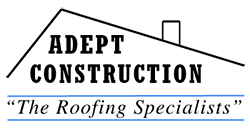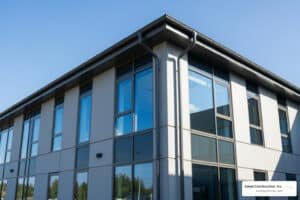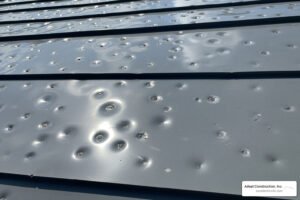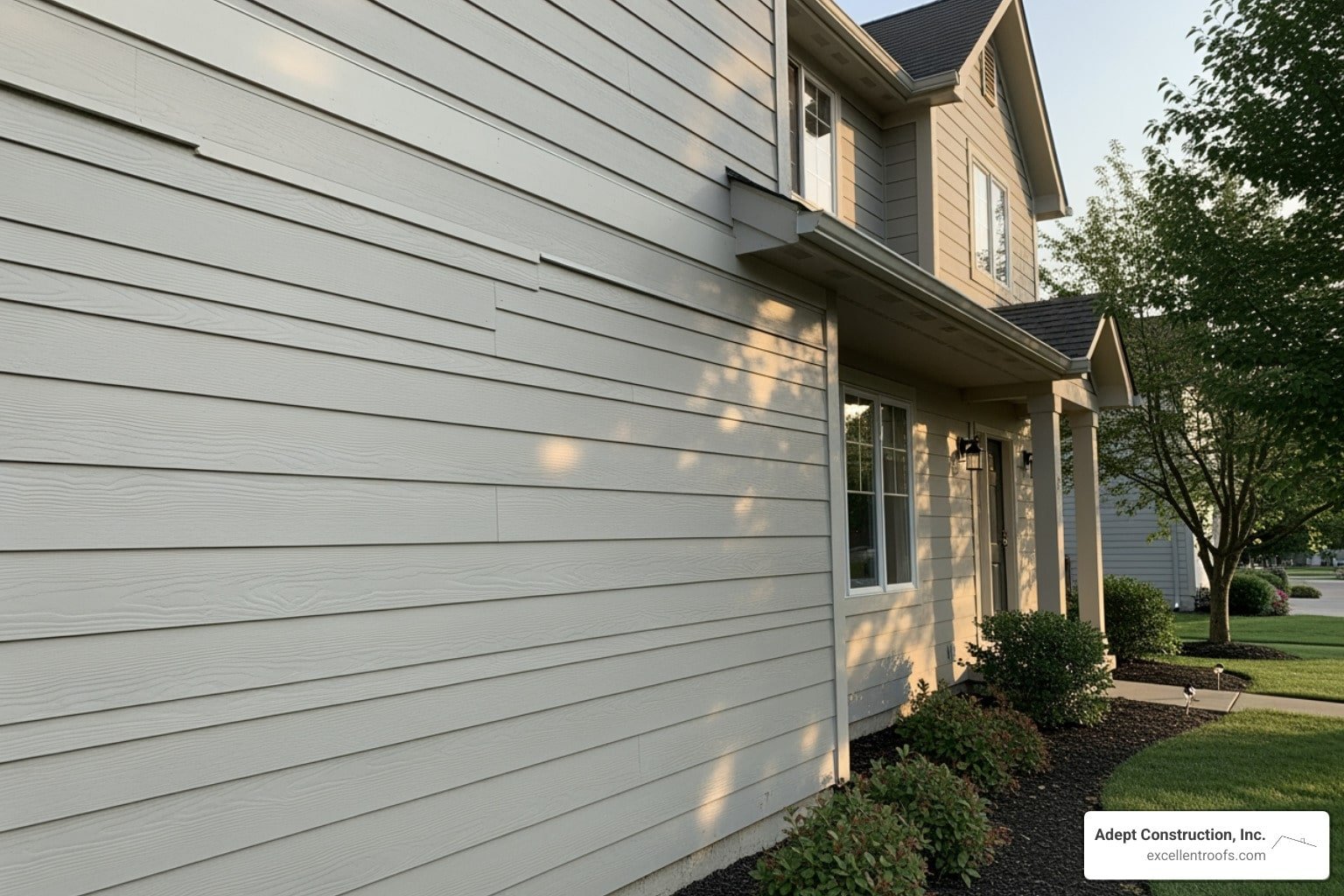
Understanding What You’ll Pay for Insulated Vinyl Siding
Insulated vinyl siding cost per square foot typically ranges between $4 and $12 installed, with most homeowners paying around $8 per square foot for a complete professional installation. As a Downers Grove roofing company, we publish cost guides like this because roof-to-wall transitions, step flashing, soffit vents, and fascia details are built and warrantied by roofing crews and must be coordinated with siding thickness and trim profiles.
Unlike standard vinyl, which costs $2 to $7 per square foot, insulated siding features a foam backing that boosts energy efficiency, durability, and noise reduction. If you are planning a roof replacement, knowing siding costs helps you budget for integrated work at eaves, rakes, and wall flashings so the entire exterior envelope performs as a system.
Quick Cost Breakdown:
- Basic Insulated Vinyl Siding: $4-$6 per square foot
- Mid-Range Options: $6-$9 per square foot
- Premium Products: $9-$12+ per square foot
- Average 1,500 sq ft Home: $6,000-$18,000 total project cost
- Materials: $2.00-$7.25 per square foot
- Labor: $3.00-$6.00 per square foot
Many homeowners in the Chicago suburbs learn that siding replacement is about more than aesthetics; it protects your home’s structure and reduces energy bills. As Gerald Michaels, founder of Adept Construction, I’ve helped countless homeowners understand the value behind their home investments. This guide breaks down every cost factor so you can budget accurately. To explore all our services, visit our homepage.
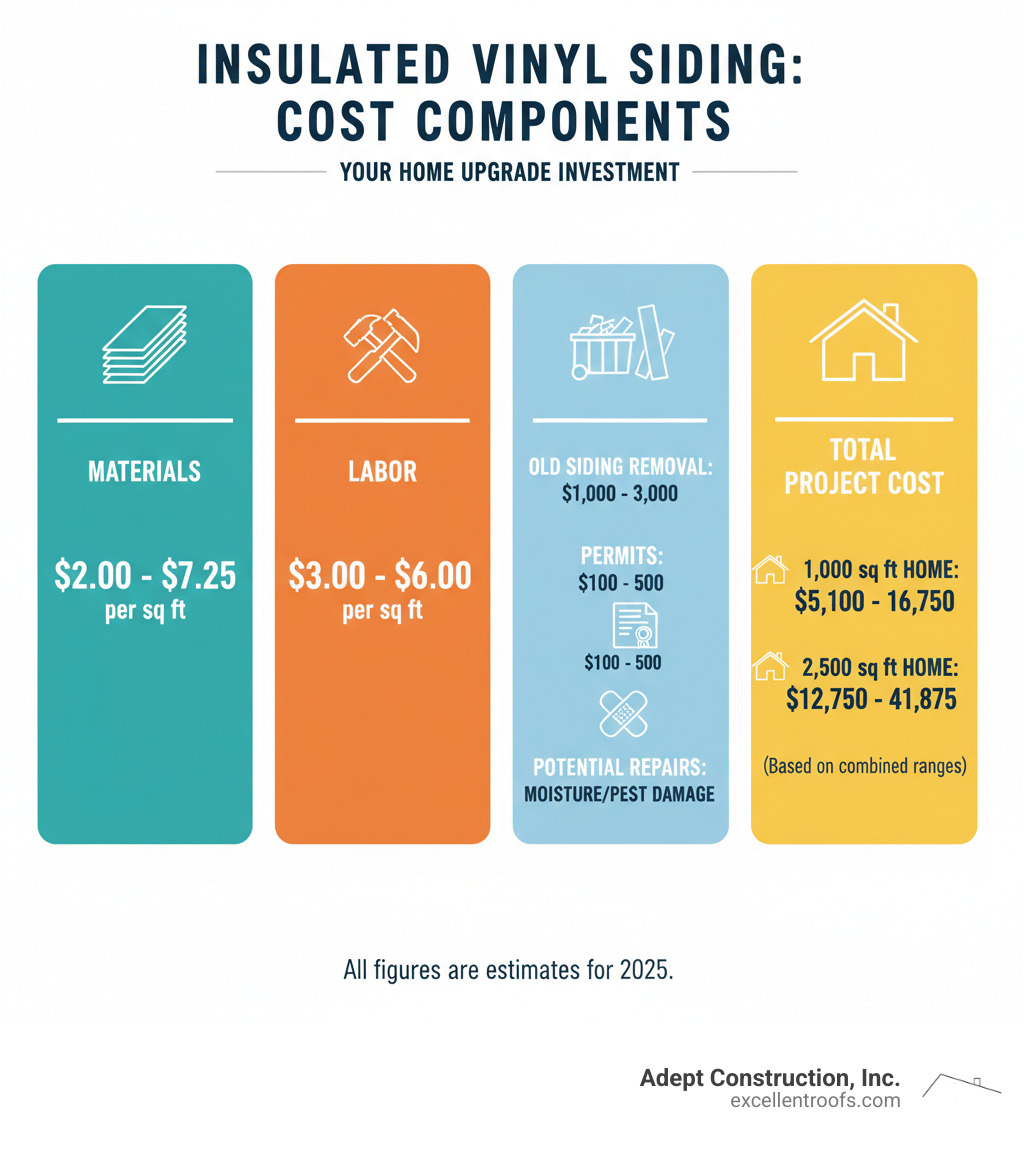
Understanding the Average Cost of Insulated Vinyl Siding
Nationally, the insulated vinyl siding cost per square foot is between $4 and $12 for professional installation. For a typical 1,500 square foot home, this means a total project investment of $6,000 to $18,000. These figures include both materials and the skilled labor needed for proper installation. From a roofing perspective, these cost ranges matter because insulated siding changes wall thickness at roof-to-wall intersections, where step flashing, counterflashing, and starter strips are installed and warrantied by your roofer.
Insulated vinyl siding is a premium product engineered to improve your home’s thermal performance, making it especially valuable in Naperville and Downers Grove, where we experience extreme temperatures. The foam backing, typically expanded polystyrene, dramatically increases the siding’s R-value—sometimes up to five times higher than traditional vinyl. This difference shows up in your monthly energy bills and complements roof insulation and attic ventilation strategies.
The Price Range for Insulated Vinyl Siding
Insulated vinyl siding comes in several tiers, each offering different features and benefits that affect performance and appearance.
| Siding Type | Cost Per Square Foot (Installed) | Material Quality | Insulation Thickness | Color & Style Options |
|---|---|---|---|---|
| Basic Insulated Vinyl Siding | $4 – $6 | Standard vinyl with thinner foam backing | Lower R-value | Limited color palette, common profiles |
| Mid-Range Insulated Vinyl Siding | $6 – $9 | Thicker vinyl, denser foam backing | Moderate R-value | Wider color selection, varied textures/profiles |
| Higher-End Insulated Vinyl Siding | $9 – $12+ | Premium vinyl, high-density contoured foam | Higher R-value | Extensive color choices, realistic wood grain, custom trim |
- Basic Tier ($4-$6/sq ft): Offers the core insulation benefit with standard vinyl and a thinner foam backing. It’s a great entry-level upgrade from traditional siding.
- Mid-Range Tier ($6-$9/sq ft): This is the most popular choice, featuring thicker vinyl panels, denser foam, and better fade resistance. You’ll find more aesthetic choices and better durability with products like CertainTeed CedarBoards or Mastic Structure EPS.
- Premium Tier ($9-$12+/sq ft): Delivers the highest R-values with advanced, contoured foam and the thickest vinyl panels (.044″ to .054″). This tier provides superior UV resistance, longevity, and access to rich, dark colors and realistic wood grain textures.
Material vs. Labor: A Cost Breakdown
Your total project cost is typically split 50/50 between materials and labor.
- Materials ($2.00 – $7.25 per sq ft): This includes the siding panels plus necessary accessories like J-channels, corner posts, trim, and house wrap, which can add another $1 to $2 per square foot.
- Labor ($3.00 – $6.00 per sq ft): Professional installation is crucial. Insulated vinyl is thicker and requires specialized techniques. Our experienced crews handle everything from preparation to cleanup, ensuring the installation meets manufacturer specifications to protect your warranty. While DIY seems tempting, improper installation can lead to moisture intrusion and reduced energy performance. For more details, see our guide on vinyl siding installation.
Coordinating siding with roofing details at eaves and roof-to-wall transitions avoids rework and ensures flashings, drip edge, and ventilation are installed once and to spec.
Key Factors That Influence the Insulated Vinyl Siding Cost Per Square Foot

Several variables impact your final project cost, explaining why two similar homes might have different price tags for siding installation. Roofing tie-ins matter here: complex rooflines add step flashing and counterflashing details wherever walls meet shingles, which increases labor coordination and the need for precise sequencing between siding and roofing crews.
Home Size and Architectural Complexity
The total square footage of your exterior walls is the starting point, but your home’s architecture plays a huge role. A simple, rectangular ranch-style home is straightforward to side. However, features like dormers, gables, turrets, and multiple stories increase labor time and material waste. Each corner, window, and door requires precise cutting and specialized trim. Multi-story homes also require scaffolding, adding to the cost. A complex 2,500 sq. ft. home could cost $10,000 to $30,000, while a simple 1,000 sq. ft. home might be $4,000 to $12,000. Dormers and roof-to-wall intersections also add roofing flashings that must be integrated with the thicker insulated panels.
Material Quality and R-Value
The quality of the siding directly impacts cost and long-term energy savings. The foam backing provides thermal resistance, measured by R-Value. While standard vinyl has an R-value of about 0.61, insulated siding achieves R-values between 2.0 and 3.5—a five-fold improvement. For Illinois, an R-value of 2.0 to 3.5 is optimal. Thicker vinyl panels (.046″ or more) offer greater durability against hail and debris. Premium colors and textured finishes that mimic wood also add to the material cost, as do products from brands with strong reputations and warranties. When integrating with roofing, verify the installed thickness so step flashing and counterflashing heights remain code-compliant and watertight.
Labor Rates and Regional Differences
Labor costs vary significantly based on your location. In Chicago suburbs like Naperville and Downers Grove, labor rates reflect a higher cost of living and strong demand for skilled tradespeople. Reputable contractors maintain proper insurance, licensing, and training, which factors into the price. While less experienced installers may offer lower rates, improper installation can lead to moisture problems and reduced energy efficiency, potentially requiring costly roof repair in Downers Grove, IL. Getting local quotes from established contractors for Downers Grove Siding provides the most accurate cost picture. Ensure your roofer and sider coordinate schedules so flashings and weather barriers are integrated correctly.
Beyond the Panels: Additional Project Costs to Consider
When budgeting, the insulated vinyl siding cost per square foot is just one part of the total expense. A complete replacement involves several other potential costs that also touch the roof system at eaves, rakes, and roof-to-wall transitions.
Removal of Old Siding
Before new siding is installed, the old material must be removed and disposed of. This service typically costs between $1,000 and $3,000, covering labor and landfill fees. This step is crucial as it allows for a thorough inspection of the underlying structure. In areas like Naperville, we often find hidden storm damage from hail or wind, which must be addressed before proceeding. Tear-off is also the point to evaluate drip edge, step flashing, and underlayment terminations at the roof perimeter so your roofing warranty remains intact.
Permits and Necessary Repairs
- Building Permits: Most siding projects require a permit, costing between $100 and $500. This ensures the work meets local safety codes.
- Underlying Damage: Once the old siding is off, we may find issues like rotted wall sheathing, moisture damage (mold, mildew), or pest damage from termites or carpenter ants. These problems must be repaired to ensure a sound foundation for the new siding.
- Fascia and Soffit: If the boards along your roofline are deteriorating, it’s cost-effective to replace them during the siding project. This is also the time to confirm soffit ventilation is unobstructed and compatible with the roof’s intake/exhaust balance.
We recommend budgeting an extra 10-20% as a contingency for potential repairs. Proactive steps like regular siding maintenance can help prevent many of these issues.
The cost of insulated vinyl siding per square foot vs. Traditional Siding
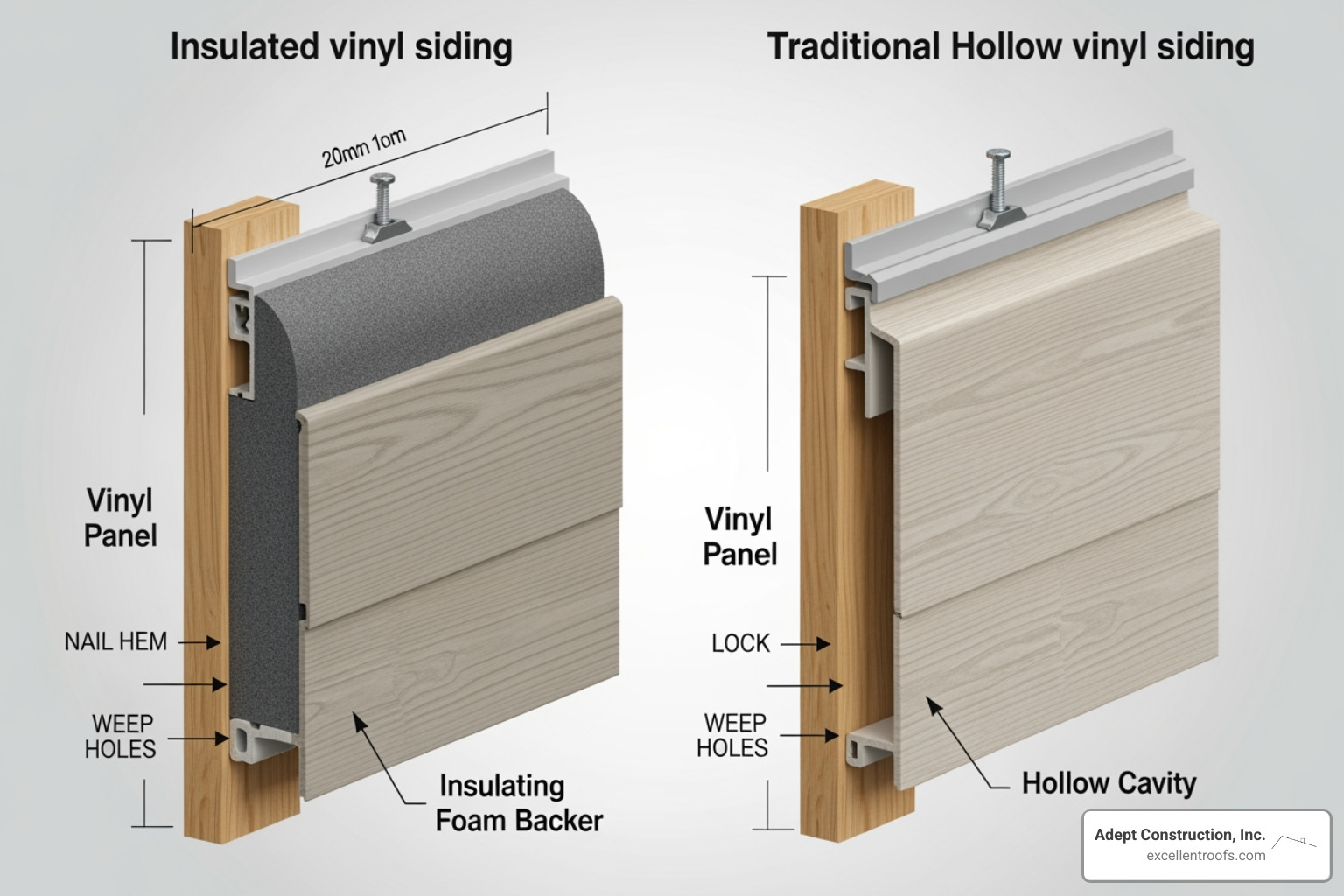
Traditional vinyl siding costs $2-$7 per square foot installed, while insulated vinyl ranges from $4-$12. While the upfront cost is higher, insulated siding offers superior value through:
- Durability: The solid foam backing provides significant impact resistance against hail, debris, and accidental bumps, preventing the dents and cracks common with hollow vinyl.
- Noise Reduction: The foam acts as a sound barrier, dampening outside noise from traffic, neighbors, and weather.
- Energy Savings: The increased R-value can reduce heating and cooling costs by an average of 14.2%, allowing the siding to pay for itself over its lifespan.
Coordinated with a well-ventilated, watertight roof system, these benefits compound to improve whole-home comfort and durability.
Is Insulated Vinyl Siding a Worthwhile Investment?
While the insulated vinyl siding cost per square foot is higher than traditional options, it delivers significant long-term benefits that make it a smart investment in your home’s future. When combined with a properly designed roofing system, the building envelope performs better against wind-driven rain, ice dams, and summer heat.
Long-Term Value and Energy Savings
The true value of insulated vinyl siding unfolds over years of performance. Key benefits include:
- Reduced Utility Bills: By creating a thermal barrier and minimizing heat loss through wall studs, insulated siding can lower energy bills by 20% or more. Over a 25 to 40-year lifespan, these savings can be substantial.
- Improved Home Comfort: It helps maintain consistent temperatures throughout your home, eliminating hot and cold spots and reducing the strain on your HVAC system.
- Improved Durability: The rigid foam backing makes panels more impact-resistant than hollow vinyl, protecting against hail, debris, and temperature fluctuations.
- Low Maintenance: Insulated vinyl resists pests, won’t rot like wood, and never needs painting. An occasional wash is all that’s needed to keep it looking new. For more tips, read our article on Vinyl Siding.
Return on Investment (ROI)
Insulated vinyl siding provides strong financial returns when it’s time to sell.
- Increased Home Value: New, energy-efficient siding signals a well-maintained home to potential buyers, justifying a higher asking price.
- Superior Curb Appeal: The rigid panels create straighter, flatter walls that eliminate the wavy look sometimes seen with hollow vinyl, closely mimicking the premium appearance of real wood.
- High Resale Value: According to Remodeling Magazine, siding replacement costs are recouped at an impressive 76.4%, outperforming many other major home improvements. An investment of $20,000 could add over $15,000 to your home’s value.
A proper siding system also protects your home’s entire structure, including the residential roofing system, by preventing moisture intrusion. Coordinating siding with roof flashings, ice and water shield at eaves, and soffit ventilation ensures the envelope acts as one system with fewer callbacks and a longer service life.
Different Types of Insulated Vinyl Siding and How Their Costs Vary
While we’ve covered cost tiers, the specific technology behind the siding explains the price differences in the insulated vinyl siding cost per square foot. The type of foam and panel thickness are key drivers of performance and price.
Basic foam-backed panels ($4-$6/sq ft installed) use a standard vinyl panel with a flat layer of foam insulation attached. This provides a good R-value improvement over hollow siding and is a cost-effective upgrade.
Mid-range options with contoured foam ($6-$9/sq ft installed) feature insulation that is molded to fit the siding profile perfectly. This custom fit eliminates air gaps, which increases thermal performance and makes the panel significantly more rigid and impact-resistant. The result is a straighter, more durable wall that better resembles real wood.
High-end insulated vinyl siding ($9-$12+/sq ft installed) combines the thickest vinyl panels (often .050″ or more) with dense, precisely contoured foam. These premium products include advanced color retention technology to prevent fading, deep wood grain textures, and comprehensive warranties. They offer the best performance, durability, and aesthetics.
When comparing products, focus on the R-value, vinyl thickness, and aesthetic options. While energy savings are significant, many homeowners find the most immediate benefits to be the superior durability and the clean, uniform appearance of the finished walls. If a roof replacement is on your near-term horizon, confirm that the chosen panel profile and foam thickness align with step flashing heights and headwall/sidewall flashing details to maintain a continuous, watertight seal.
How Regional Differences Affect the Price of Insulated Vinyl Siding
The insulated vinyl siding cost per square foot varies significantly by location. In Naperville, IL, and Downers Grove, IL, costs tend to be in the mid-to-high end of the national average due to several local factors.
- Cost of Living: As prominent Chicago suburbs, our area has a higher cost of living, which translates to higher labor rates for skilled, experienced installers. You are paying for proven craftsmanship and local accountability.
- High Demand: These are thriving communities where homeowners invest in quality improvements. Strong demand for reputable contractors can influence pricing but also ensures access to top-tier professionals.
- Midwestern Climate: Our hot summers and cold winters create strong demand for energy-efficient solutions like insulated siding. Homeowners recognize the long-term value in reducing heating and cooling bills.
- Local Codes: Building codes in Naperville and Downers Grove ensure high standards for safety and quality, which can sometimes influence material or installation requirements.
For the most accurate pricing, get quotes from local contractors who understand the market conditions in Naperville and Downers Grove. At Adept Construction, we have served these communities for nearly three decades and provide fair, competitive pricing based on local expertise. Code-driven details at roof edges—like ice and water shield, drip edge, and minimum flashing heights—should be coordinated with insulated panel thickness and trim to pass inspection and protect warranties.
Frequently Asked Questions about Insulated Siding Costs
How long does insulated vinyl siding last?
Professionally installed, high-quality insulated vinyl siding can last 25 to 40 years or even longer. Its longevity depends on proper installation, the local climate, and minimal maintenance (occasional cleaning). The foam backing adds rigidity, which helps prevent cracking and damage over time, giving it a durability advantage over traditional vinyl. Proper integration with roof flashings and drip edge at eaves also reduces water intrusion risk over the long term.
Can I install insulated vinyl siding myself to save money?
We strongly advise against DIY installation for insulated vinyl siding. It is thicker, heavier, and requires specialized tools and techniques to create a weatherproof seal. Improper installation can void the manufacturer’s warranty and lead to costly problems like moisture intrusion. Water damage behind siding can affect your home’s structure and may even require professional services like roof repair in Naperville, IL if it compromises the roof system. Hiring a professional ensures the job is done right, maximizing performance and longevity.
How do I get an accurate estimate for my home?
The best way to determine your project’s cost is to schedule an in-person consultation with a qualified contractor. An online calculator cannot account for your home’s unique architecture or the condition of the existing structure. A professional will measure your home, assess its complexity, discuss material options, and provide a detailed, itemized quote covering everything from tear-off and permits to final cleanup. We recommend getting at least three estimates from reputable local contractors to compare services and pricing.
Should I coordinate siding work with a roof replacement?
Yes. Bundling siding with a planned roof replacement reduces mobilization costs, ensures continuous weather barriers, and lets your roofer set step flashing, counterflashing, drip edge, and ventilation details once and to spec. This approach improves warranty protection and reduces the chance of leaks at roof-to-wall intersections.
Get a Professional Estimate for Your Siding Project
Understanding the insulated vinyl siding cost per square foot is a great start, but a professional estimate is the only way to know your true project cost. While national averages range from $4 to $12 per square foot, your home’s unique architecture and condition will determine the final price.
At Adept Construction, we provide expert assessments of your home’s complete exterior needs. With nearly three decades of experience serving Naperville and Downers Grove, we know that a simple ranch home requires a different budget and approach than a multi-story home with complex dormers. That’s why we offer free, in-person consultations. When your project includes roof-to-wall intersections or eave work, our roofing team ensures flashings, drip edge, and ventilation align perfectly with your new insulated siding.
During your estimate, we will measure your home, evaluate its complexity, discuss your goals, and provide a detailed, transparent quote. We inspect for underlying issues to prevent surprise costs, ensuring a smooth process from start to finish.
Whether you need siding in Naperville or Downers Grove, we are here to help you make an informed decision. Ready to see what your project will cost? Contact us today for a free, no-obligation estimate and invest wisely in your home’s future.

